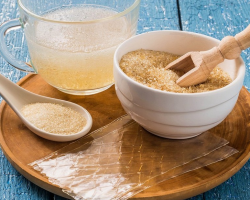Bingers are one of the most dangerous childhood infectious diseases that requires urgent treatment. The course of the disease and the condition of the child largely depend on the correct timely actions of the parents.
Content
- The causes of whooping cough
- How does a whooping cough manifest in children? Signs
- Cowcam: symptoms in children up to a year
- How is cough transmitted in children?
- Cough: diagnostics in children
- When do they take the analysis for whooping cough in children?
- How to cure a cough in a child?
- Complication after whooping cough in children
- What to do if there are suspicions of whooping cough in a child?
- Treatment of pertussis in children with drugs and folk remedies
- Video: Treatment of pertussis with folk remedies
- Prevention of whooping cough
- Video: Koklush - School of Dr. Komorovsky
A cough is a disease that affects the respiratory tract and is characterized by a cough with spasms. The causative agent is a whooping stick, opened in 1906 by the Belgian Borde and the Frenchman Jing.

The causes of whooping cough
The source of the disease is an infected person. Merogy bacteria are transmitted by airborne droplets, but at the same time differ in low stability, so you can get infected only with prolonged close contact.
Important: Parents, if possible, must limit their contacts of their children not vaccinated from cough with coughing people.
How does a whooping cough manifest in children? Signs
The most important thing is to distinguish whooping cough from ordinary cold in time.
The incubation period of the disease can last up to three weeks, but more often limited to 5-7 days.
Important: there are no special clinical manifestations of the disease at this time, but the child is already sick and is a source of infection.
Next comes the catarrhal period, during which bacteria multiplication on the walls of the respiratory tract occurs. The clinic is insignificant: the child coughs, sneezes, a runny nose begins, an increase in temperature is observed up to 39 ° C.

Gradually, the cough frequency increases, turning into spasmodic attacks. At the same time, sputum secretions still do not occur.
During the attack, the child begins to literally choke, since cough tremors do not allow him to get in light air.
Important: with such cramps, blood pressure increases and, therefore, small hemorrhages in the capillaries of the eyes are possible. Sentorous bouts, especially persistent and frequent at night, are often accompanied by vomiting and even involuntary allocation of urine and feces.

Such a clinic is a peak of a spasmodic period. After that, the frequency of seizures is reduced, the cough from the “pertussis” passes into ordinary, which is the norm for the latter, permitting the period of the disease.
The child recovers, although the cough can hold out for another 10-15 days. The total duration of the disease is 6-8 weeks.
Cowcam: symptoms in children up to a year
In infants, the first two periods of whooping cough are practically absent, which is characteristic of severe forms of the course of the disease.
Although the coughing attacks are shorter, “oxygen starvation” is observed in all tissues and organs of the baby. Therefore, often a cough is accompanied by a loss of consciousness, convulsions, stopping breathing.

Important: if the latter occurred, it is necessary to artificially cause vomiting in a child, pressing on the root of the tongue. This will help restore the respiratory process.
How is cough transmitted in children?
Miller bacteria are very whimsical microbes. They quickly die, so the probability of infection of the child through household items (toys, dishes, underwear) is minimal. What can not be said about the direct contact of children with each other.
Kids communicate, hug, kiss-this is a great opportunity to catch the pathogen transmitted by airborne droplets from an infected child.

Important: if, the child is sick with whooping cough, it is better to take walks with him away from playgrounds and attractions. So you will protect other children from infection, and your child from joining a new infection.
Cough: diagnostics in children
It is very difficult to diagnose the disease at an early stage - in the catarrhal period, especially in children under the age of six months, since their whooping cough occurs atypically.

- If the child has an unusually strong cough and general malaise, you need to do bacteriological analysis
- The material for sowing is taken with a curved swab from the back of the pharynx and placed in the Wednesday of the Bord-Jingle (glycerin-cartel blood agar)
- Title sticks give growth after 72 - 96 hours in the form of small colonies of an oily consistency with a metallic shine (like drops of mercury)
- You can also diagnose the disease reaction of immunofluorescence or the polymerase chain reaction methodallowing to detect microbes in strokes of nasopharyngeal mucus
Important: bacteriological confirmation of the diagnosis of whooping cough allows you to isolate the sick child from the children's team in a timely manner and thereby prevent the further spread of the disease.
When do they take the analysis for whooping cough in children?
If the child is ill, and, according to the anamnesis, contacted coughing children, it's time to take tests for whooping cough:
- First you need to hand over general (clinical) blood test. It is needed in order to determine the presence of any infection in the body. Since whooping cough has a bacterial nature, the level of leukocytes in the blood will be increased, and lymphocytes will prevail in the leukocyte formula, the rest of the indicators will not change significantly
- If the disease goes into a severe form, then you need to pass general urine analysisand blood chemistryto determine possible complications
- It is also necessary to hand over general analysis of the discharge from the respiratory tract - Sputum. The method lies in the fact that at the time of the attack, the open cup with a nutrient medium is brought to the child’s mouth, on which droplets of mucus containing the pathogen of infections are settled during cough.
- No less important immunological tests of blood and nasal secretions. This analysis determines the content of immunoglobulin m in the blood, and in the nasal mucus - immunoglobulin A - antibodies to a stick that provokes whooping cough.
- In addition, before the start of treatment, it is carried out bacterial sowingthat finds a cough stick 3 to 4 days after the analysis

How to cure a cough in a child?
Since whooping cough has a bacterial nature, you can get rid of it only with antibiotics intended for the treatment of various infectious diseases of the respiratory tract:
- erythromycin
- rovamycin
- tetracycline
- azithromycin
- ampicillin
Important: treatment with antibacterial drugs should last at least 10 days.
In parallel with the main treatment, other products from coughing should be used. But it must be remembered that none of the syrups will cure the cough, but only helps not to pick up a secondary infection that can develop against the background of whooping cough: bronchitis, pneumonia or pleurisy.

Complication after whooping cough in children
The severe course of the disease in a child can lead to negative consequences for the body:
- Reducing the stability of capillaries often provokes nasal bleeding, hemorrhage in the retina of the eye And, extremely rarely, in brain with subsequent paralysis of the central nervous system
- Due to violation of the respiratory process, it is possible the development of pathology in the lungs of the child
- The presence of coccal flora in the body can lead to development of streptococcus, staphylococcus, pneumococcus
- Cases of development are not rare bronchitis, pleurisy, pneumonia

What to do if there are suspicions of whooping cough in a child?
The most important thing is not to panic, but to consult a doctor in a timely manner and take a blood test with a leukocyte formula. Having received the result, the doctor will see the presence of a disease.
You also need to hand over the material for bacteriological sowing, the results of which with maximum accuracy will show the presence or absence of whooping sticks in the child's body.
Treatment of pertussis in children with drugs and folk remedies
In most cases, cough treatment in children occurs at home. However, if infants are sick up to six months, or there is a strong complication of the course of the disease in an older child, then it is safer to undergo treatment in a hospital.
Important: one of the important conditions of treatment is the regime and diet. Such components of therapy can easily be organized at home.
The food consumed by the child should be full and vitaminized. You need to eat often, but dosed, since the specifics of the course of the disease can cause vomiting.

Daily long walks are mandatory, but away from places of mass accumulation of people, and even more so for children. A positive effect has a long stay of the patient in reservoirs.
Important: symptomatic treatment includes the intake of antipyretic drugs (if the child’s temperature is above 38 ° C), antibiotics prescribed by the attending physician, antitussive drugs, sedatives, syrups to improve sputum and inhalations with eufillin.
Many mothers do not leave without attention and means of traditional medicine, which have been reflected in the advice of grandmothers, mother -in -law, neighbors and friends.
There are a lot of options and recipes. Nevertheless, there are the main components of the preparation of cocktails of cough wand: onions, garlic, honey and milk in combinations taken by the child-and the disease will be easier and the probability of secondary infection will be minimized.

Recipe No. 1. Chopped garlic (50g) and thyme (30g) place in an enameled container, pour water (0.5l) and put on low fire. Give the decoction to boil well, then remove it from the fire, cool and strain it. Add honey (250g) to the liquid part and mix well. Syrup give the child 3 - 4 times a day for 1 tsp. After each meal.
Recipe No. 2. Boil a large onion, finely chop and mix with honey in a ratio of 1: 1. Every hour to offer a child this medicine in minimal portions (1/4 - 1/6 tsp).
Recipe No. 3. Mix honey (150g) with home butter (100g). The means to give the child three times a day, 1 tsp. after meal.
Recipe No. 4. Grate the horseradish root (100 g) on \u200b\u200ba fine grater and mix with honey (100g). Take twice a day for 1 tsp.
Recipe No. 5. In boiling milk (1 tbsp.) Add 5 cloves of garlic and boil for 5 -7 minutes. Offer the child this broth several times a day. Let him drink how much he can.
Recipe No. 6.Mix butter and pork fat in equal proportions. Add grated garlic (3 cloves per 100 g of agents) and mix thoroughly. Rub the chest and back of the child in the absence of fever.

Recipe No. 7. Grind the root of the licorice (300g), boil in milk (1l) for 7-10 minutes. Cool, strain, add honey (2 tbsp). Take warm, 3 times a day for 1 tsp.
Recipe No. 8.Finely chop the onion (2 pcs.), Mix with sugar (2 tbsp). Leave to infuse at night in a closed bowl. In the morning, the mixture is ceiling and strain. Onion-sacherous syrup take 1 tbsp. During coughing attacks.
Video: Treatment of pertussis with folk remedies
Prevention of whooping cough
Mostly children are sick of cough. An infection is transmitted from patients with airborne droplets.
Important: due to the low resistance of the bacteria of cough, the role of various objects surrounding the patient is very insignificant, so it makes no sense to carry out disinfecting measures.
- It is necessary to isolate the infected child as soon as possible, and on the children contacting with him to apply quarantine for 14 days from the moment of the last communication with the sick
- Since the late 50s of the 20th century, developed countries are vaccinated against whooping cough with murled capcquisers associated with diphtheria and tetanus anxin (DTP)
- Kids are vaccinated three times from a three -month age every 45 days. Then, at 18 months, revaccination is carried out

Since the dead bacteria are very strong allergens, artificial vaccines are now used, consisting of individual components of the dead microorganisms, which are enough for the child to develop active immunity to pertress.








Thank God we easily suffered whooping cough. I then re -read a bunch of articles. This one helped a lot: http://rainbowbaby.ru/koklyush-u-detej/. I recommend to read. Health to your children